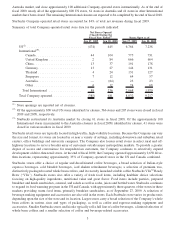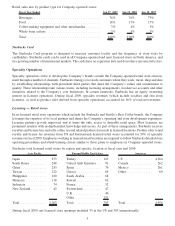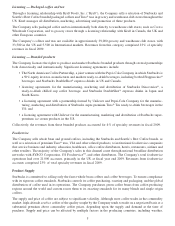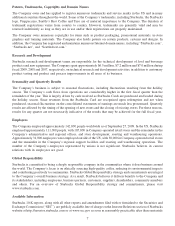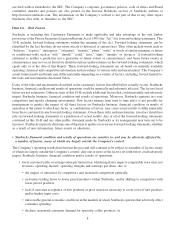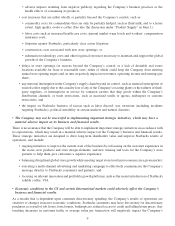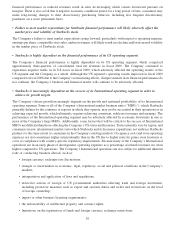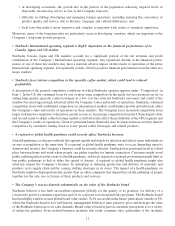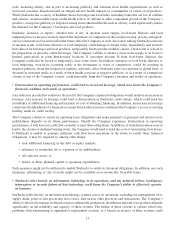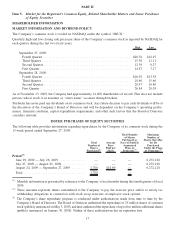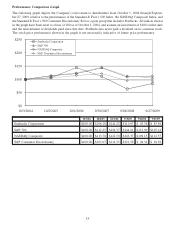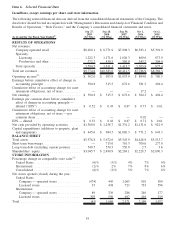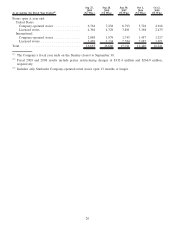Starbucks 2009 Annual Report Download - page 18
Download and view the complete annual report
Please find page 18 of the 2009 Starbucks annual report below. You can navigate through the pages in the report by either clicking on the pages listed below, or by using the keyword search tool below to find specific information within the annual report.financial performance as reduced revenues result in sales de-leveraging which creates downward pressure on
margins. There is also a risk that if negative economic conditions persist for a long period of time, consumers may
make long-lasting changes to their discretionary purchasing behavior, including less frequent discretionary
purchases on a more permanent basis.
•Failure to meet market expectations for Starbucks financial performance will likely adversely affect the
market price and volatility of Starbucks stock.
The Company’s failure to meet market expectations going forward, particularly with respect to operating margins,
earnings per share, comparable store sales, and net revenues, will likely result in a decline and/or increased volatility
in the market price of Starbucks stock.
•Starbucks is highly dependent on the financial performance of its US operating segment.
The Company’s financial performance is highly dependent on its US operating segment, which comprised
approximately three-quarters of consolidated total net revenues in fiscal 2009. The Company continued to
experience negative traffic in its US stores in fiscal 2009, which adversely affected the operating results of the
US segment and the Company as a whole. Although the US segment’s operating results improved in fiscal 2009
compared to fiscal 2008 due to the Company’s restructuring efforts, if improvements in its financial performance do
not continue, the Company’s business and financial results will continue to be adversely affected.
•Starbucks is increasingly dependent on the success of its International operating segment in order to
achieve its growth targets.
The Company’s future growth increasingly depends on the growth and sustained profitability of its International
operating segment. Some or all of the Company’s International market business units (“MBUs”), which Starbucks
generally defines by the countries or regions in which they operate, may not be successful in their operations or in
achieving expected growth, which ultimately requires achieving consistent, stable net revenues and earnings. The
performance of the International operating segment may be adversely affected by economic downturns in one or
more of the Company’s large MBUs. Additionally, some factors that will be critical to the success of International
MBUs are different than those affecting the Company’s US stores and licensees. Tastes naturally vary by region, and
consumers in new international markets into which Starbucks and its licensees expand may not embrace Starbucks
products to the same extent as consumers in the Company’s existing markets. Occupancy costs and store operating
expenses are also sometimes higher internationally than in the US due to higher rents for prime store locations or
costs of compliance with country-specific regulatory requirements. Because many of the Company’s International
operations are in an early phase of development, operating expenses as a percentage of related revenues are often
higher compared to US operations. The Company’s International operations are also subject to additional inherent
risks of conducting business abroad, such as:
• foreign currency exchange rate fluctuations;
• changes or uncertainties in economic, legal, regulatory, social and political conditions in the Company’s
markets;
• interpretation and application of laws and regulations;
• restrictive actions of foreign or US governmental authorities affecting trade and foreign investment,
including protective measures such as export and customs duties and tariffs and restrictions on the level
of foreign ownership;
• import or other business licensing requirements;
• the enforceability of intellectual property and contract rights;
• limitations on the repatriation of funds and foreign currency exchange restrictions;
10





